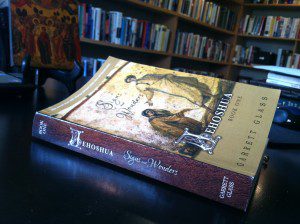 “People have been looking for Jesus for a long time, but never quite like this.” – N.T. Wright, “Five Gospels but No Gospel”
“People have been looking for Jesus for a long time, but never quite like this.” – N.T. Wright, “Five Gospels but No Gospel”
I’ve heard many descriptions of the historical Jesus over the years. Garrett Glass’ Jesus seems as unfamiliar to me as any. Billed as a work of historical fiction, the self-published Jehoshua: Signs and Wonders is heavy on the fiction… not so much on the history, though.
I’ve been reading this book for a few weeks now, off and on. I’m having roughly the same reaction to it that I had to Reza Aslan’s Zealot. In order to hit with the pros when it comes to the historical Jesus, you have to be a pro yourself. This has to be your discipline. To write well in this sub-genre (Historical Fiction/New Testament Era), requires not only expertise in literature/creative writing, but also a massive amount of reading and study in ancient near eastern culture, languages, archaeological research, text critical studies, as well as discussion with experts in the field. You have to read and assimilate at least the major works that comprise the full spectrum of modern historical Jesus scholarship. That, plus you have to be a brilliant writer who, having done all the research, knows how far to push without overreaching. It’s an incredibly demanding discipline. Which is probably why it’s not often attempted, and rarely done well. I know I could never do it.
Jehoshua is meant to be a fictional telling of the first 25 years of the Christian movement. Predictably, Glass’ Jesus is not divine, doesn’t do miracles, and did not rise from the dead–although he is so overweight they need extra rope to keep him on the cross. He also introduces the possibility that his real father is a Roman soldier named Pantera (insert Life of Brian jokes here… “Your father is a Roman, Brian!”). Moving against the four biblical Gospels’ interpretation of Jesus’s life, Glass envisions a movement that came about as a result of Jewish and Roman cultural-political machinations, committed or deluded followers, as well as a cloying portion of happenstance.
The project is ambitious, and his stories are interesting at times. The back matter includes appendices with some rudimentary historical facts, and a bibliography, which in and of itself is odd. I don’t remember seeing a bibliography in a work of non-scholarly historical fiction before. However, the list provides some insight into Glass’ influences. It reads like a who’s who of the Jesus Seminar: John Dominic Crossan, Marcus Borg, Robert Funk, Burton Mack, Karen King, John S. Kloppenborg, James Robinson—all Charter Fellows of the Jesus Seminar, plus other controversial scholars like Bart Ehrman and John Shelby Spong.
To be sure, any survey of historical Jesus scholarship work has to include Crossan, Borg, Mack, et al. But too many names are missing. Notably absent are people like N.T. Wright (who has to be at the top of any list of living historical Jesus scholars), Ben Meyers, Anthony Harvey, E.P. Sanders, or even a more popular name like A.N. Wilson. (If you ever want to trace the history of historical Jesus scholarship, Wright has written a concise survey called Who Was Jesus). The result is that Glass seems to have based his view of Jesus and the early church on the historical findings of only a few closely aligned scholars occupying ground far outside the mainstream—ground that has not yet been won in terms of the wider scholarly debate. Glass takes a bag full of these strands of (dubious) historical detail and attempts to weave every single one of them into the narrative. The result is that the story often feels contrived. For instance:
- Glass creates the character Lamech, who bought Jesus’ cloak from the Roman Soldier who won it gambling. Lamech cuts the cloak and sells it as a nostrum to people who believed Jesus had healing powers. When Lemech discovers that he physically resembles Jesus (in a day before photographs it was easier to pull this off), he pretends to be the risen Lord in order to make money, fooling even Jesus’ closest friends. Hence the plausible explanation for any and all risen Jesus encounters.
- Mary Magdalene’s reputation for harlotry stems not from her experiences as a prostitute, but her experiences with Jesus. Glass’ explanation in Appendix A says, “This is not a novel idea; others have explored the possibility that Jehoshua, as a human, might have had a sexual nature and sexual experiences with women, or even men (what was he doing alone with that young man in the garden of Gesthemane?” [sic – typos abound in the book]. Jesus is portrayed as soaking up the adoration of the crowds and channeling it into his own sexual experiences with Mary and others. It’s cliché. Just once I want a liberal historical Jesus writer to say Mary Magdalene was a typical divorced woman forced into occasional prostitution in order to eat because the culture was horrible to women.
- Jesus is never resurrected, and is never even buried. Instead he is thrown off the side of the hill where he was killed, torn to pieces, and eaten by a pack of wild dogs.
- The more outlandish historical possibilities (Jesus was overweight, bi-sexual, and the bastard son of a Roman soldier, or the constant plausible explanations for anything that smacks of metaphysics) are introduced as subtle suggestions–inner dialogue from the supporting cast, a fleeting thought, or unresolved possible explanation by a character.
The downside of a story like this is that it blurs the lines between fact and fiction excusing anything they author presents that might in fact be misleading or outright wrong as just part of a made up story. It’s like when my kids say something cruel, followed by “I’m just kidding.” Over the course of the novel, it starts to feel disingenuous, if not fantastic.
The upside of Glass’ attempt to retell the story of early Christianity is that he roots the story of the early church firmly in the narrative of Israel and 2nd Temple Judaism. Whatever historical details might be off, Glass sidesteps the fatal mistake of most liberal tellings of the early Jesus story by acknowledging the early Christian movement as a fundamentally Jewish reality (whether he gets that Jewish reality right or not is another story).
In his introduction, Glass states that Jehoshua is not “intended to be a challenge to anyone’s beliefs as a Christian. I am not trying to convert people away from Christianity.” The front cover, however, reads “The novel that will change forever your view of Christianity.” Given the material in the front and back matter, it seems clear that Glass has a more polemical agenda in mind. Glass says he writes for an audience of Christians who are open to “alternate endings of the Passion story,” Christians who are distanced from the faith, completely secular, or those who have opted out of Christianity altogether. I think all of those audiences would benefit from a more thoroughly researched novel.
If you are so inclined you might try: Anne Rice’s Christ the Lord: Out of Egypt, Christ the Lord: The Road to Cana; Nikos Kazantzakis’ The Last Temptation of Christ; Anita Diamant’s The Red Tent; or one of my personal favorites The Lost Letters of Pergamum by Bruce Longenecker.












